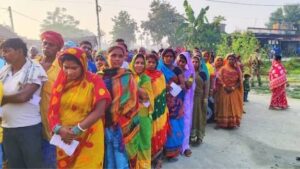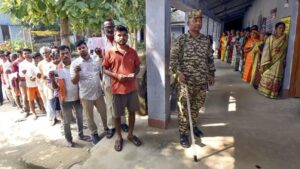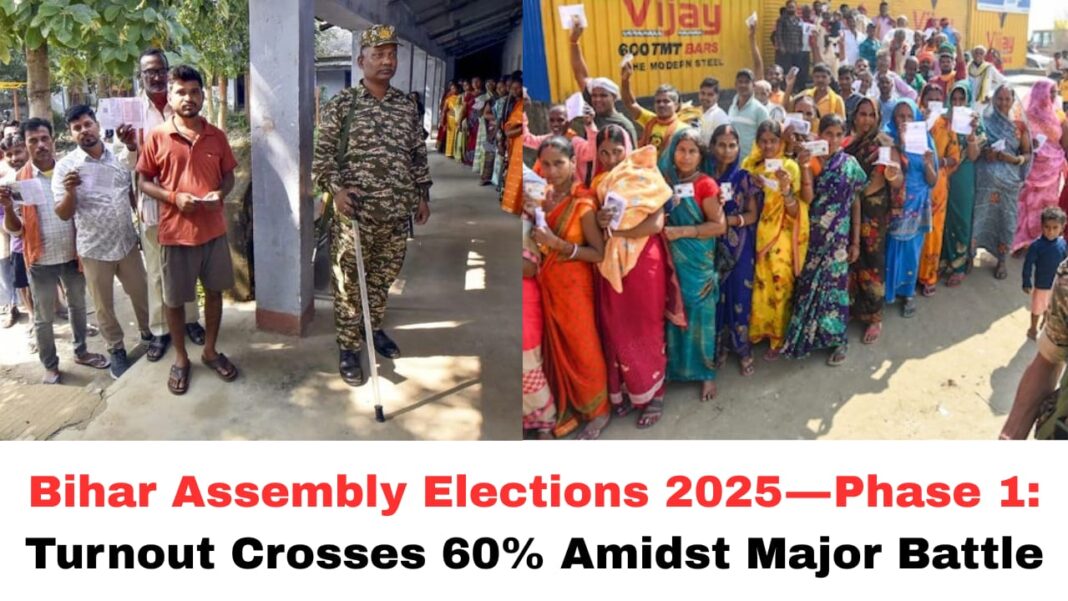Digital News Guru Bihar Desk:
Bihar 2025 Assembly Elections — Phase 1 Update
The political atmosphere in Bihar is electrified as the first phase of the state assembly elections unfolded on 6 November 2025, covering 121 constituencies across 18 districts. With roughly 3.75 crore voters eligible in this phase, the scale of the exercise is enormous and closely watched.
Turnout & Trends
- As of 1 p.m., voter turnout stood at 42.31 %.
- By 5 p.m., the figure climbed to about 60.13 %, an uptick of around 4–5 points compared to comparable past phases.
- Some districts recorded notable figures: for example, Begusarai witnessed around 67.32 %, while Sheikhpura was lower at about 52.36 %.

- Early impressions suggest heightened voter enthusiasm, especially among first-time voters and youth, described by some as a “quiet revolution” in participation.
What’s at stake
This election is not just a state-level affair — it carries broader implications:
- The ruling National Democratic Alliance (NDA), led in Bihar by the Janata Dal (United) (JD(U)) and the Bharatiya Janata Party (BJP), faces a stern challenge from the opposition Rashtriya Janata Dal (RJD)-led Mahagathbandhan.
- The outcome in Bihar’s 243-seat assembly can influence national-level politics, given the state’s electoral weight and the upcoming general elections.
- The electoral roll underwent significant revision beforehand, which itself became a topic of contention.
Key personalities and narratives
- Leaders such as Tejashwi Yadav (RJD’s chief ministerial hopeful), Nitish Kumar (Bihar CM and JD(U) leader), and Samrat Choudhary (BJP deputy CM) cast their votes early, underlining the high stakes.
- In several rural booths, voters turned up in large numbers, even taking selfies after voting — a sign of increased engagement.

Process & administration
To ensure smooth and fair polling, several measures were deployed:
- Polling began at 7 a.m. and in most areas continued till 5 p.m. or 6 p.m., though some booths ended earlier due to security concerns.
- The Election Commission of India (ECI) introduced web-casting at polling stations and capped the number of electors per booth to reduce crowding.
Notable issues & dynamics
- Voter enthusiasm: The high turnout is seen as a sign of strong public engagement and could favour change or reaffirmation depending on how parties mobilise.
- Key personalities: RJD’s Tejashwi Yadav (CM-face for opposition) and BJP’s Samrat Choudhary (important NDA leader) are both in the fray.
- Electoral roll controversy: About 65 lakh names were removed from the rolls after the Special Intensive Revision exercise, leading to opposition claims of bias.
- Infrastructure & fairness: The Election Commission of India (ECI) has taken steps such as web-casting at polling booths, and limiting electors per polling station to improve transparency and accessibility.
Observations & analysis
- The turnout above 60 % indicates robust voter enthusiasm and may serve as a “mood-meter” for how the electorate is feeling about the status quo.
- However, higher turnout does not automatically translate into a particular party’s victory — the distribution of votes across constituencies, demographic shifts, and local issues will matter.

What to watch next
- Results day: The counting for all 243 seats is scheduled for 14 November 2025.
- Phase 2 polling (for the remaining constituencies) will provide a clearer picture of momentum and whether trends seen in Phase 1 hold across the state.
- Which constituencies swing in favour of which alliance, especially swing seats, will be critical. Micro-trends — rural vs urban, youth turnout, first-time voters — will matter.
- Post-poll: the formation of the government, whether one alliance secures a clear majority or needs to cobble coalition support, will determine the political narrative for the next term.
- The implications for national politics: if the opposition performs strongly in Bihar, it could energise similar strategies in other states or alter the narrative for the next general election.
Conclusion
Phase 1 of Bihar’s 2025 assembly elections has delivered a clear message: voters are engaged and turnout is solid. Whether that translates into shifted power will depend on granular results, not just headline figures. The stakes are high — not only for Bihar, but for the political trajectory of India’s larger democratic contest.
You May Also Read: Rishabh Pant Returns for India vs South Africa Starting 14 November








